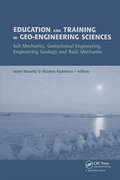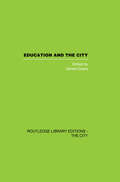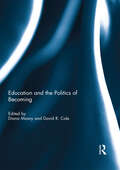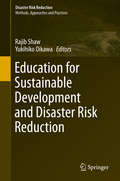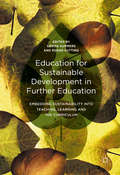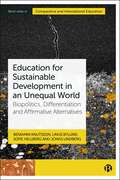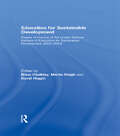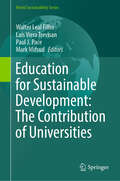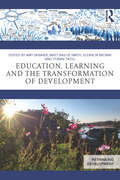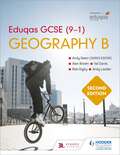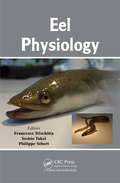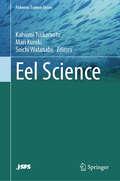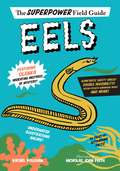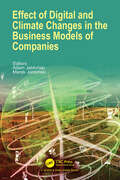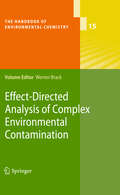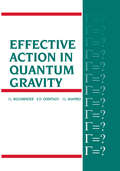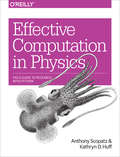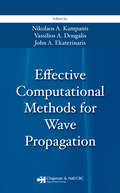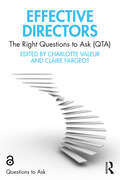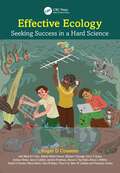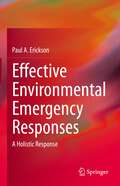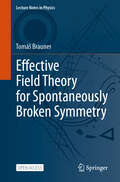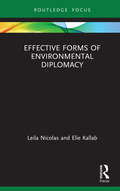- Table View
- List View
Education and Training in Geo-Engineering Sciences: Soil Mechanics and Geotechnical Engineering, Engineering Geology, Rock Mechanics
by Iacint Manoliu Nicoleta RadulescuCovering a broad range of topics (curricular matters in geo-engineering education, teaching; learning and assessment in geo-engineering education; challenges in geotechnical engineering education; issues in education and training in Engineering Geology; the link university -professional world in geo-engineering, this book will be invaluable to university teachers, academics and professionals involved in education and training in geo-engineering sciences.
Education and the City: Theory, History and Contemporary Practice
by Gerald GraceCity schools, especially those attended by working class and ethnic minority pupils are teh catalysts of many significant issues in educational debate and policy making. They bring into sharp focus questions to do with class, gender and race relations in education; concepts of equality of opportunity and of social justice; and controversies about the wider political economic and social context of mass schooling. America, Western Europe and Australia have all taken a keen interest in the problems of urban schooling. The contributors to this collection of original essays all share a concern about these problems, although they approach them from a wide range of theoretical and ideological positions. Gerald Grace and his contributors criticis the current limitations of urban education as a field of study and they present a foundation for a more historically located and critically informed inquiry into problems, conflicts and contradictions in urban schooling. Part I presents contributions on theories of the urban. Part II focuses upon the history of urban education both in Britain and the USA. Part III discusses contemporary policy and practice with essays relating to education in inner city London and in New York City. This book was first published in 1984.
Education and the Politics of Becoming
by Diana MasnyThis collection examines education in the light of a politics of becoming. It takes a non-hierarchical transdisciplinary approach, challenging the macropolitics of pre-established governmental and economic agendas for education. Drawing on the philosophy of Gilles Deleuze and Felix Guattari, the contributors consider questions such as how education might engage a politics of becoming, and how education and becoming function in a society of control. Since Deleuze and Guattari contend that a society is defined by its becomings, its transformations, this collection asks how education, itself a process in becoming, may contribute "collective creations" to a society in continual flux.The chapters bring theory and praxis together, deploying power, affect, cartography, space, relationality, assemblage and multiple literacies in order to experiment with music, art, language, teacher education, curriculum and policy studies. This collection is an innovative resource, creating an encounter with the macropolitics of education, and altering teaching, learning, evaluation and curriculum. This book was originally published as a special issue of Discourse: Studies in the Cultural Politics of Education.
Education for Sustainable Development and Disaster Risk Reduction
by Rajib Shaw Yukihiko OikawaEducation for Sustainable Development (ESD) and Disaster Risk Reduction Education (DRRE) have overlapping areas of concern focusing on strengthening the link to local communities. In reality, there is significant synergy in ESD and disaster risk reduction (DRR). Both concepts urge looking at the communities, both focus on behavior changes and both call for linking knowledge to action. The Decade of Education for Sustainable Development (DESD) ends in 2014 and the Hyogo Framework for Action (HFA) ends in 2015. Therefore, at this junction, it is important to review the progress made over the past 10 years and to suggest future synergy options. This book is the first attempt to review these two emerging fields and to provide input to the future direction of education. The book has 11 chapters, drawing lessons mainly from Japan and discussing their implications for the world. The first four chapters provide an overview of the ESD-DRR linkage, ESD and its evolution, DRRE and Climate Change Education. These are followed by case studies from ESD practices in Japan, in schools, universities and communities. The primary target groups for this book are students and researchers in the fields of environment, disaster risk reduction and climate change studies. The book provides them with a good idea of the current research trends in the field and furnishes basic knowledge about these vital topics. Another target group comprises practitioners and policy makers, who will be able to apply the knowledge collected here to establishing policy and making decisions.
Education for Sustainable Development in Further Education
by Denise Summers Roger CuttingThisbook will enable teachers and managers in the post-compulsory sector to considera range of approaches to embed Education for Sustainable Development (ESD) intheir practice in the post-compulsory sector. There will be the opportunity to consider key debates, useful links andsuggested reading to encourage further investigation and development ofpractice. Fundamentally, this book aimsto empower teachers to critically analyse ESD through their own subjectspecialisms, engage in the debate and learn with their students. Democratic and participative approachesintroduced will help readers to question traditional transmissive styles ofteaching and learning and move on to the radical and transformative approachesrequired to embrace ESD. Therefore this book, whilst including illustrativeexamples, will encourage the reader to look at their own subject specialisms,practice, interests and those of their students to co-construct a curriculum thatembeds ESD.
Education for Sustainable Development in an Unequal World: Biopolitics, Differentiation and Affirmative Alternatives (Bristol Studies in Comparative and International Education)
by Sofie Hellberg Jonas Lindberg Beniamin Knutsson Linus BylundEducation for Sustainable Development (ESD) is recurrently depicted as an enterprise that unites humanity in a common pursuit of a more just and sustainable world. But how is this enterprise pursued on a planet that is enormously unequal? Drawing on biopolitical theory and rich empirical data from different contexts around the world, this book explores how ESD is unpacked depending on whether people are rich or poor. The book demonstrates how ESD is adapted to the lifestyles and living conditions of different populations. The implication of this depoliticized sensitivity to local ‘realities’, the book argues, is that inequality becomes accommodated and that different responsibilities are assigned to rich and poor. Ultimately, the book considers alternatives to this biopolitical divide.
Education for Sustainable Development: Papers In Honour Of The United Nations Decade Of Education For Sustainable Development (2005-2014)
by David Higgitt Martin Haigh Brian ChalkleyIn 2005, The United Nations launched its Decade of Education for Sustainable Development, which recognises that education, including Higher Education is the key to the change in social attitudes that will be needed to protect the welfare of future generations. This involves helping learners to live as though the future matters and to achieve ecoliteracy. This includes the understanding that personal lifestyle decisions may have consequences, ranging from climate change, through loss of biodiversity, to pollution and resource depletion that may permit environmental degradation on a planetary scale. It also involves helping them to develop the skills needed to cope with such challenges. This international collection of research papers and position statements from special issues of the Journal of Geography in Higher Education and Applied Environmental Education and Communication, written by many of the leading practitioners in the field, aims to provide resources and practical guidance for all seeking to promote and engage in education for a sustainable future. Rabindranath Tagore encouraged each learner to make their actions demonstrate a harmonious union between education and environment. David Orr argued that the world needs people who live well in their places to make the world both habitable and humane and that the main challenge for education is to help learners make their minds fit for life on Earth. This book tries to chart a practical route towards these objectives. This book was previously published as special issues of the Journal of Geography in Higher Education and Applied Environmental Education and Communication
Education for Sustainable Development: The Contribution of Universities (World Sustainability Series)
by Walter Leal Filho Mark Mifsud Laís Viera Trevisan Paul J. PaceAs we confront the daunting challenges of the 21st century—climate change, social inequality, resource depletion, and the loss of biodiversity—the role of education has emerged as a pivotal force in driving transformative change. "Education for Sustainable Development: The Contribution of Universities" is a response to this urgent call for a reimagined educational landscape, one that empowers current and future generations to navigate and address the complexities of sustainability. This book seeks to outline universities' critical role as catalysts for sustainable development. As centres of knowledge creation, innovation, and community engagement, universities possess the unique ability to influence not only individual lives but also societal norms and practices. They are uniquely positioned to integrate sustainability into their curricula, research agendas, and outreach efforts, thus fostering a culture of sustainability that permeates all aspects of academic life. The need for Education for Sustainable Development (ESD) has never been clearer. By emphasising sustainability in higher education, we can raise awareness among students and faculty, inspiring them to become informed and engaged global citizens. This book serves as a comprehensive resource, offering insights, best practices, and real-world examples of how universities around the globe are advancing the principles of ESD. Within this book, the readers will find a rich tapestry of ideas and strategies designed to encourage institutions to embrace sustainability in a holistic manner. From innovative teaching methods to collaborative community partnerships, this collection reflects the diversity of approaches being implemented in universities today. It is our hope that the experiences shared will serve as a source of inspiration for educators, administrators, and policymakers. Ultimately, this book stands as a testament to the belief that education is a powerful tool for creating a more sustainable and equitable world. By fostering a deep understanding of sustainability and its interconnected dimensions, we can equip students with the knowledge and skills necessary to tackle the pressing issues we face. Together, through a collective commitment to Education for Sustainable Development, we can cultivate a better future for generations to come.
Education, Learning and the Transformation of Development (Rethinking Development)
by Amy Skinner, Matt Baillie Smith, Eleanor Brown and Tobias TrollWhilst education has been widely recognised as a key tool for development, this has tended to be limited to the incremental changes that education can bring about within a given development paradigm, as opposed to its role in challenging dominant conceptions and practices of development and creating alternatives. Through a collection of insightful and provocative chapters, this book will examine the role of learning in shaping new discourses and practices of development. By drawing on contributions from activists, researchers, education and development practitioners from around the world, this book situates learning within the wider political and cultural economies of development. It critically explores if and how learning can shape processes of societal transformation, and consequently a new language and practice of development. This includes offering critical accounts of popular, informal and non-formal learning processes, as well as the contribution of indigenous knowledges, in providing spaces for the co-production of knowledge, thinking and action on development, and in terms of shaping the ways in which citizens engage with and create new understandings of ‘development’ itself. This book makes an important and original contribution by reframing educational practices and processes in relation to broader global struggles for justice, voice and development in a rapidly changing development landscape.
Eduqas GCSE (9-1) Geography B Second Edition
by Alan Brown Bob Digby Andy Leeder Andy Owen Val DavisDevelop your students' subject knowledge and skills using this second edition Eduqas GCSE (9-1) Geography B Student book.Featuring updated case studies, practice questions and clear presentation of key terms, this thoroughly revised edition provides students with the up-to-date knowledge they need to succeed at GCSE.- Enhances students' subject knowledge, critical thinking and problem-solving skills using clear explanations of geographical issues, brought to life through an exciting, enquiry-based approach- Teaches students how to interpret, analyse and evaluate geographical information through a range of progressive, skills-building activities that use real-place data, maps and photographs- Boosts candidates' confidence approaching examination by providing opportunities for practice for each assessed theme- Highlights possible fieldwork projects and contains guidance on carrying out investigations that meet the changed assessment requirements
Eduqas GCSE (9-1) Geography B Second Edition
by Alan Brown Bob Digby Andy Leeder Andy Owen Val DavisDevelop your students' subject knowledge and skills using this second edition Eduqas GCSE (9-1) Geography B Student book.Featuring updated case studies, practice questions and clear presentation of key terms, this thoroughly revised edition provides students with the up-to-date knowledge they need to succeed at GCSE.- Enhances students' subject knowledge, critical thinking and problem-solving skills using clear explanations of geographical issues, brought to life through an exciting, enquiry-based approach- Teaches students how to interpret, analyse and evaluate geographical information through a range of progressive, skills-building activities that use real-place data, maps and photographs- Boosts candidates' confidence approaching examination by providing opportunities for practice for each assessed theme- Highlights possible fieldwork projects and contains guidance on carrying out investigations that meet the changed assessment requirements
Eel Physiology
by Francesca Trischitta Yoshio Takei Philippe SébertEel of the genus Anguilla is an extraordinary fish, which due to its particular life cycle has fascinated biologists and physiologists ever since the pioneering works of Homer H. Schmidt in the 1930s. The Eel has become an excellent model for various aspects of adaptive physiological research. Despite that, several books dealing with eel biology, a
Eel Science (Fisheries Science Series)
by Katsumi Tsukamoto Mari Kuroki Soichi WatanabeThis book is a compilation of eel research and fish migration studies for more than 40 years showing the research history and recent advances in eel studies. Dr. Katsumi Tsukamoto, the esteemed editor of this book, has been actively involved in eel research as one of the leading scientists in the world for a long time, and he and his team successfully collected the fertilized eggs and spawn-condition adult eels from the wild for the first time in the world. This book compiles the essentials of the scientific findings obtained by the editor and his colleagues and reviews the latest references of eel science. Knowledge and information in the book such as a spawning area survey, research on artificial production of glass eels, the discovery of a new species, etc. will attract the reader’s interest, as these are written based on the authors’ experiences. Readers can obtain a comprehensive understanding of eels from various aspects of eel science including the cultural and socio-economic importance of eels and valuable scientific information using state-of-the-art approaches. The book also endeavors to contribute to the conservation of eel species, some of which have been classified as endangered by the IUCN and to promoting harmonious coexistence between humans and nature.
Eels (Superpower Field Guide)
by Rachel Poliquin Nicholas John FrithThis fourth installment in the hilarious and highly illustrated full-color Superpower Field Guide series features Olenka, an ordinary eel. Olenka may be slimy, wiggly, and the color of mud, but never, ever underestimate an eel. Meet Olenka, an ordinary eel. Did I hear you say, &“But aren&’t eels just long slippery slimy fishy-things that . . . hmm . . . . Is there anything else to know about eels?&” You bet your buttons there is! Sit back and hold on tight, because Olenka is going to amaze you with superpowers such as double invisibility and shape-shifting, and the super secret Lair of the Abyss (that means a top-secret deep-sea hideout). In fact, Olenka's life is so impossibly extraordinary, it has baffled the smartest scientists in the world for thousands of years. &“Impossible!&” you say. I say, "you don&’t know eels." But you will. Includes a ruler printed along the edge of the book&’s back cover to aid the observations of young field scientists everywhere!
Effect of Digital and Climate Changes in the Business Models of Companies
by Adam Jabłoński Marek JabłońskiThe aim of the monograph is to present a modern and original approach towards designing and implementation of effective solutions that ensure an induction towards positive climate change. The monograph presents the application of digital business models and strategies combining solutions of digital and climate transformation. The monograph presents a set of digital solutions that change the functioning of technical organizations in a multiple crisis environment. Applied technological management supported by elements of automation and robotics will shape the emergence of new climate services. The described mechanisms for implementing cybersecurity and safety principles will serve to reduce climate threats.
Effect-Directed Analysis of Complex Environmental Contamination
by Werner BrackToday more than 5 million chemicals are known and roughly 100,000 of them are frequently used, with both numbers rising. Many of these chemicals are ultimately released into the environment and may cause adverse effects to ecosystems and human health. Effect-directed analysis (EDA) is a promising tool for identifying predominant toxicants in complex, mostly environmental mixtures combining effect testing, fractionation and chemical analysis. In the present book leading experts in the field provide an overview of relevant approaches and tools used in EDA. This includes diagnostic biological tools, separation techniques and advanced analytical and computer tools for toxicant identification and structure elucidation. Examples of the successful application of EDA are discussed such as the identification of mutagens in airborne particles and sediments, of endocrine disruptors in aquatic ecosystems and of major toxicants in pulp and paper mill effluents. This book is a valuable, comprehensive and interdisciplinary source of information for environmental scientists and environmental agencies dealing with the analysis, monitoring and assessment of environmental contamination.
Effective Action in Quantum Gravity
by I.L BuchbinderIn part one of Effective Action in Quantum Gravity, the book describes the principles of quantum field theory and the significance of and theory behind effective action. Part two deals with quantum field theory in curved space-time and the effective action. These two parts provide the tools for understanding the rest of the book, which is devoted to selected problems of quantum gravity where the effective action plays a major role. The book assumes only a basic understanding of quantum field theory and general relativity and will be of interest to postgraduate students and researchers in theoretical high-energy physics and gravitational theory.
Effective Computation in Physics: Field Guide to Research with Python
by Kathryn D. Huff Anthony ScopatzMore physicists today are taking on the role of software developer as part of their research, but software development isnâ??t always easy or obvious, even for physicists. This practical book teaches essential software development skills to help you automate and accomplish nearly any aspect of research in a physics-based field.Written by two PhDs in nuclear engineering, this book includes practical examples drawn from a working knowledge of physics concepts. Youâ??ll learn how to use the Python programming language to perform everything from collecting and analyzing data to building software and publishing your results.In four parts, this book includes:Getting Started: Jump into Python, the command line, data containers, functions, flow control and logic, and classes and objectsGetting It Done: Learn about regular expressions, analysis and visualization, NumPy, storing data in files and HDF5, important data structures in physics, computing in parallel, and deploying softwareGetting It Right: Build pipelines and software, learn to use local and remote version control, and debug and test your codeGetting It Out There: Document your code, process and publish your findings, and collaborate efficiently; dive into software licenses, ownership, and copyright procedures
Effective Computational Methods for Wave Propagation
by Nikolaos A. Kampanis Vassilios A. Dougalis John A. EkaterinarisDue to the increase in computational power and new discoveries in propagation phenomena for linear and nonlinear waves, the area of computational wave propagation has become more significant in recent years. Exploring the latest developments in the field, Effective Computational Methods for Wave Propagation presents several modern, valuable
Effective Directors: The Right Questions to Ask (QTA) (Questions to Ask (QTA))
by Charlotte ValeurThe ebook will be Open Access and made available on publication. Being a good board member is not about knowing everything; it is about asking the right questions and challenging appropriately. Effective Directors: The Right Questions To Ask (QTA) is a reference book for board members and executives globally to support them in their work. With chapters written by senior company board members and respected figures in corporate governance, the questions have been drawn together to offer food for thought and useful prompts that take boards beyond operational discussions. The book clearly presents key areas to be considered by the board (there are over 50 in total) and range from board composition, to data security, diversity and inclusion, and succession planning. The questions are ones that boards, in any organisation, should be asking themselves, their fellow board members, service providers, executives, and other stakeholders to ensure that the right issues are raised, transparency and effective oversight are achieved, and the board is fulfilling its role in governing the organisation. In addition to being invaluable for board members, the book is also a very useful tool for executives in understanding the kind of questions their board members are likely to ask, and the kind of questions that should be asked and discussed in the boardroom.
Effective Ecology: Seeking Success in a Hard Science
by Roger D. CousensEcology is one of the most challenging of sciences, with unambiguous knowledge much harder to achieve than it might seem. But it is also one of the most important sciences for the future health of our planet. It is vital that our efforts are as effective as possible at achieving our desired outcomes. This book is intended to help individual ecologists to develop a better vision for their ecology – and the way they can best contribute to science. The central premise is that to advance ecology effectively as a discipline, ecologists need to be able to establish conclusive answers to key questions rather than merely proposing plausible explanations for mundane observations. Ecologists need clear and honest understanding of how we have come to do things the way we do them now, the limitations of our approaches, our goals for the future and how we may need to change our approaches if we are to maintain or enhance our relevance and credibility. Readers are taken through examples to show what a critical appraisal can reveal and how this approach can benefit ecology if it is applied more routinely.Ecological systems are notable for their complexity and their variability. Ecology is, as indicated by the title of this book, a truly difficult science. Ecologists have achieved a great deal, but they can do better. This book aims to encourage early-career researchers to be realistic about their expectations: to question everything, not to take everything for granted, and to make up their own minds.
Effective Environmental Emergency Responses: A Holistic Response
by Paul A. EricksonThis book focuses on the variety of subsequent consequences that may follow the conclusion of the immediate emergency response effort, consequences that require multi-disciplinary efforts and most likely may require a revamping of the historical interplay of national and other political authorities. The book is essentially a critique of contemporary emergency response which, in both the public perception and, unfortunately, in the mind-set of many practicing professionals emphasizes an emergency as a singular event. It is a mistaken view: an emergency is actually a sequence of multiple, singular events that unfold over time, sometimes measured in days and weeks and, most often, in months, years and decades. This book focuses on the need, in the current and recent past generation to revamp our thinking about planning for and responding comprehensively to those periodic disruptions to daily routine we call "emergencies".
Effective Field Theory for Spontaneously Broken Symmetry (Lecture Notes in Physics #1023)
by Tomáš BraunerThis open access book is about spontaneous symmetry breaking, which is a classic area of theoretical physics that lies at the core of many fascinating phenomena such as ferromagnetism, superfluidity, superconductivity, or the Higgs mechanism. The book brings an up-to-date overview of spontaneous symmetry breaking and of modern effective field theory description thereof. The topics covered include the classification of Nambu–Goldstone bosons, nonlinear realization of internal and spacetime symmetries and the construction of the corresponding effective actions, and selected applications. With in-depth exposition of conceptual foundations and numerous illustrative examples, the book is accessible to anybody having taken a basic course on quantum field theory. It serves as a self-contained text for graduate students and junior researchers in diverse areas of physics, but also as a useful reference for experts.
Effective Forms of Environmental Diplomacy (Routledge Focus on Environment and Sustainability)
by Leila Nicolas Elie KallabThis book holistically covers the issue of environmental diplomacy by building a firm foundation for readers to understand the different dimensions of the topic. The book begins by exploring the progress the world community has made in understanding the importance of diplomacy in preserving the environment for humankind's survival, peace, and security. Then, it critically analyses the existing system of international environmental treaties and highlights its political and legal gaps. It further examines specific case studies on multilateral diplomacy as well as both formal and informal diplomacy in cases from Europe and the United States to evaluate the diplomatic models followed by different stakeholders in the field. Through this case study analysis, the book develops theoretical and empirical frameworks that can be applied to study how international and regional organisations and NGOs maintain and put forward environmental agendas at an international level. It also examines the effect of the COVID-19 pandemic on the environment to highlight the challenges to reach an effective and equitable environmental governance and draw conclusions around effective versus ineffective forms and tools of environmental diplomacy. This book will be of great interest to students and scholars of environmental diplomacy and environmental law and governance, as well as practitioners working in this important field.
Effective Non-Hermiticity and Topology in Markovian Quadratic Bosonic Dynamics (Springer Theses)
by Vincent Paul FlynnThis thesis provides an in-depth investigation of effective non-Hermiticity and topology in many-mode, non-interacting, bosonic systems. It also establishes the extent to which one must move beyond the Hamiltonian, closed-system setting, in order to uncover signatures of genuine symmetry-protected topological (SPT) physics in "free" (mean-field) bosons. While SPT phases of free fermionic matter and their associated zero-energy boundary-localized modes have been thoroughly explored, similar physics in free bosonic systems still remains elusive. No fermionic counterpart exists for the distinctive dynamical behavior that arises from the effective non-Hermiticity, intrinsic even at equilibrium, to bosonic Hamiltonians. Therefore, a much needed paradigm shift is required to address major conceptual roadblocks in the search for SPT bosonic phases.The analysis within develops, in particular, the notion of topological metastability in quadratic bosonic systems subject to Markovian dissipation. The resulting dynamical paradigm was found to be characterized by both a sharp separation between transient and asymptotic dynamics and non-trivial topological invariants. It also features long-lived boundary-localized "Majorana boson" and "Dirac boson" modes, which realize tight bosonic analogues to the edge modes characteristic of fermionic SPT phases. This comprehensive look into non-interacting bosonic systems breaks important new ground for re-imagining quantum phenomena beyond equilibrium, with novel applications in quantum science.
